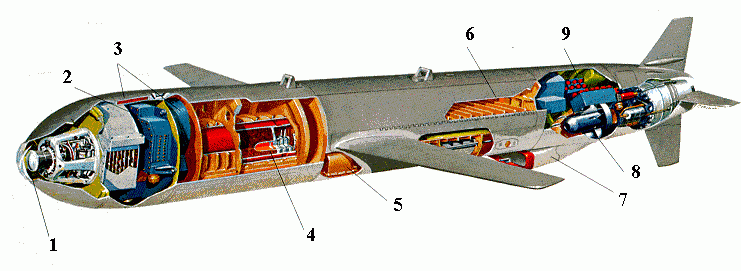- infrared front view sensor;
- DSMAC subsystem unit;
- communication channel;
- combat unit with fail-safe mechanism ;
- illuminator of subsystem DSMAC;
- fuel tank and power drives for wing deployment;
- air intake of TWRD and thermopile;
- air inlet and thermobattery; marshal TWRD;
- TERCOM subsystem unit;
The missile consists of six compartments with a solid rocket engine (RDTT) docked to the last compartment.
The launch solid fuel engine (length 0.8 m, weight 297 kg) develops a thrust of 3200 kgf, its operating time is 6-7 seconds. It has a thrust vector deflection system (maximum deflection angle about 10°) in the form of four gas rudders located on the nozzle cut.
The marching engine is a small-size turbojet twin-shaft F-107 engine with a low degree of dual-circuitness and mixing of the flows of both circuits in the nozzle. The low pressure cascade consists of a two-stage fan and a two-stage unregulated compressor driven by a two-stage turbine. The fan and compressor in the low pressure turbine are on the same shaft, where a medium pressure compressor is also installed. The high-pressure cascade consists of one turbine-driven, unregulated centrifugal compressor. The engine runs as follows. The air flow from the air intake enters the two-stage, non-adjustable low pressure compressor. Part of the air from there is directed to the external circuit and the rest to the medium pressure compressor first, then the high pressure compressor and the combustion chamber. Fuel is fed into the engine by a displacement system. The engine is started by an ignition system equipped with two capacitively-charged spark plugs. The candles are located in the front area of the circular combustion chamber. For a reliable start of the cooled engine, oxygen is supplied to the candles. The ignition system operates continuously during the flight of the Ring Camera. If the engine shuts down, it is restarted.
